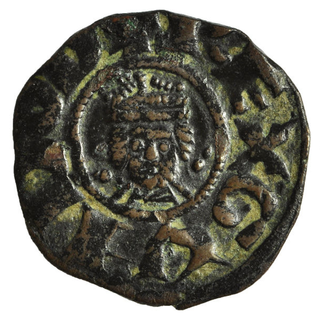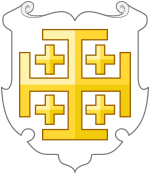
Amalric or Amaury I was King of Jerusalem from 1163, and Count of Jaffa and Ascalon before his accession. He was the second son of Melisende and Fulk of Jerusalem, and succeeded his older brother Baldwin III. During his reign, Jerusalem became more closely allied with the Byzantine Empire, and the two states launched an unsuccessful invasion of Egypt. He was the father of three future rulers of Jerusalem, Sibylla, Baldwin IV, and Isabella I.

Melisende was Queen of Jerusalem from 1131 to 1153, and regent for her son between 1153 and 1161, while he was on campaign. She was the eldest daughter of King Baldwin II of Jerusalem, and the Armenian princess Morphia of Melitene.

Baldwin IV of Jerusalem (1161–1185), known as the Leper King, was the king of Jerusalem, from 1174 until his death in 1185. He was admired by his contemporaries and later historians for his willpower and dedication to the Latin Kingdom in the face of debilitating leprosy. Choosing competent advisers, Baldwin ruled a thriving crusader state and succeeded in protecting it from the Muslim ruler Saladin.

Guy of Lusignan was a French Poitevin knight who reigned as the king of Jerusalem from 1186 to 1192 by right of marriage to Sibylla, and King of Cyprus from 1192 to 1194.

Sibylla was the queen of Jerusalem from 1186 to 1190. She reigned alongside her husband Guy of Lusignan, to whom she was unwaveringly attached despite his unpopularity among the barons of the Kingdom of Jerusalem.

Isabella I was reigning Queen of Jerusalem from 1190 to her death in 1205. She was the daughter of Amalric I of Jerusalem and his second wife Maria Comnena, a Byzantine princess. Her half-brother, Baldwin IV of Jerusalem, engaged her to Humphrey IV of Toron. Her mother's second husband, Balian of Ibelin, and his stepfather, Raynald of Châtillon, were influential members of the two baronial parties. The marriage of Isabella and Humphrey was celebrated in Kerak Castle in autumn 1183. Saladin, the Ayyubid sultan of Egypt and Syria, laid siege to the fortress during the wedding, but Baldwin IV forced him to lift the siege.

Agnes of Courtenay was a Frankish noblewoman who held considerable influence in the Kingdom of Jerusalem during the reign of her son, King Baldwin IV. Though she was never queen, she has been described as the most powerful woman in the kingdom's history after Queen Melisende.

A queen regnant is a female monarch, equivalent in rank, title and position to a king. She reigns suo jure over a realm known as a kingdom; as opposed to a queen consort, who is married to a reigning king; or a queen regent, who is the guardian of a child monarch and rules pro tempore in the child's stead or instead of her husband who is absent from the realm, be it de jure in sharing power or de facto in ruling alone. A queen regnant is sometimes called a woman king. A princess regnant is a female monarch who reigns suo jure over a principality; an empress regnant is a female monarch who reigns suo jure over an empire.

The king or queen of Jerusalem was the supreme ruler of the Kingdom of Jerusalem, a Crusader state founded in Jerusalem by the Latin Catholic leaders of the First Crusade, when the city was conquered in 1099. Most of them were men, but there were also five queens regnant of Jerusalem, either reigning alone suo jure, or as co-rulers of husbands who reigned as kings of Jerusalem jure uxoris.

The House of Lusignan was a royal house of French origin, which at various times ruled several principalities in Europe and the Levant, including the kingdoms of Jerusalem, Cyprus, and Armenia, from the 12th through the 15th centuries during the Middle Ages. It also had great influence in England and France.

Reginald Grenier was lord of Sidon and an important noble in the late-12th century Kingdom of Jerusalem.

Maria Komnene, Latinized Comnena, was the queen of Jerusalem from 1167 until 1174 as the second wife of King Amalric. She occupied a central position in the Kingdom of Jerusalem for twenty years, earning a reputation for intrigue and ruthlessness.
Jure uxoris describes a title of nobility used by a man because his wife holds the office or title suo jure. Similarly, the husband of an heiress could become the legal possessor of her lands. For example, married women in England and Wales were legally incapable of owning real estate until the Married Women's Property Act 1882.
Stephanie of Courtenay was a Latin noblewoman from the crusader states who served as the abbess of Great Saint Mary's in Jerusalem. She belonged to the House of Courtenay which ruled the County of Edessa and worked to further her abbey's wealth and standing. She is best known as a source of information for William of Tyre's chronicle of the crusader states.
This page is based on this
Wikipedia article Text is available under the
CC BY-SA 4.0 license; additional terms may apply.
Images, videos and audio are available under their respective licenses.
























